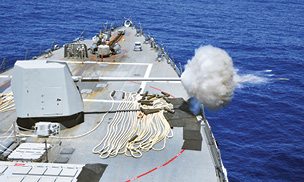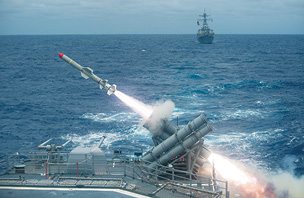At the command of the gunner, the FCS fires the gun. This gun can fire in rapid succession since the shells are loaded into the gun through an automatic loader. The destroyer has one such gun and the cruiser has two (one at the front and another at the back).
For medium-range engagements, Aegis system feeds the target coordinates to Harpoon anti-ship missile’s FCS. For targets beyond the radar horizon, the carrier-borne AEW aircraft or even satellites provide the target’s location. These transmit data to the carrier from where it is transferred to the Aegis C2 system and then to Harpoon’s FCS.


Harpoon’s FCS derives the trajectory to be followed by the missile and programmes it into the navigation system of the missile. When fired, Harpoon being a fire-and-forget missile flies itself towards the target and destroys it. Initially, Harpoon uses its navigation system to fly the trajectory entered into its guidance system by its FCS. Upon nearing the target, say, 40km, it uses its radar seeker and finds its intended target.
Tackling asymmetric threats. The general perception of US Naval planners was that elements of a CSG are slightly vulnerable to anti-ship missiles. But sub-surface and surface threats were considered as well covered due to CSG’s superior radar/sonar and offensive capabilities. They expected that such long-, medium- and close-range threats would be neutralised by these capabilities before these would indeed become an actual threat.
But the art of war is not static; it is highly dynamic. New types of threats emerge at any point of time. On October 12, 2000, an American Aegis destroyer called USS Cole felt the brunt of such a new threat. This new threat was suicide boats. USS Cole docked in Aden harbour for refuelling. After some time, a small boat approached the destroyer at high speed. Before anyone knew why it was approaching at such high speed, the boat rammed the ship and exploded. A huge hole was created on the hull and 17 US Navy personnel were killed, almost sinking the ship. Later investigations and analyses showed that the blast was caused by Al Qaeda suicide terrorists.
After the attack on USS Cole, gravity of the emerging scenario was realised. These boats presented themselves as small-size fast-moving targets. Such targets are difficult to shoot down by the 12.6cm (5-inch) guns of Aegis ships. Moreover, technologies are already in place for remotely piloting such boats. So dozens of such boats can simultaneously engage each escorting Aegis ship and damage it. Such attacks are called swarming attacks (like a group of honey bees attacking an animal). It was realised that if such a swarming boat attack is successful, Aegis escorts will probably sink progressively, thus leaving the carrier vulnerable and on its own.
Such boats could only be shot down by manually-fired light cannons (type of heavy machine guns). Normal machine guns fire slugs, whereas, these light cannons fire explosive shells. But with both the ships and fast-moving target boats being heaved by waves, these machine guns were not efficient.
When the ship heaves up/down, the shooter has to tilt the gun downwards/upwards to hit the target. It is difficult to shoot a single target, but it is practically impossible to shoot down a swarm of suicide boats. So a sophisticated weapon system was needed, and that resulted in the development of MK-38 machine gun system (MK-38 MGS).
This weapon system, a computer-controlled system, takes commands from the shooter sitting at a remote console, present somewhere deep inside the ship. For this weapon system, an electro-optical sight (EOS) acts as the eye. This is a video camera that can see even in Stygian darkness. The EOS and the gun are situated on the same mount. Both the gun and the EOS can be trained to an angle simultaneously, and also the EOS can be trained separately. This is done through the remote console that contains a pair of joysticks, one each for the EOS and the gun.
A 30.5cm (12-inch) colour LCD displays real-time imagery from the EOS. Various zoom levels are possible to have a closer look at possible targets (suspicious boats). The EOS computer also generates crosshairs in the LCD screen. These crosshairs are used by the remote operator to aim at the target. The remote operator, with just a flick of a switch, can select from two different types of ammunition depending upon the combat situation.










